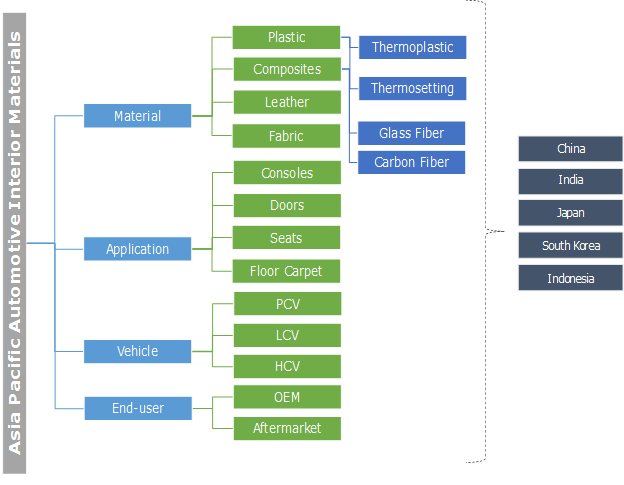According to the Graphical Research new growth forecast report titled “Asia Pacific Automotive Interior Materials Market Size, By Material (Plastic [Thermoplastic, Thermosetting], Composites [Glass Fiber, Carbon Fiber, Natural Fiber], Leathers, Fabric), By Application (Consoles & Dashboard, Doors, Seats, Steering Wheel, Floor Carpet, Others), By Vehicles (Passenger Cars, LCV, HCV), Industry Analysis Report, Country Outlook, Application Potential, Price Trend, Competitive Market Share & Forecast, 2020 - 2026”, to Witness Steady Growth by 2026

Asia Pacific interior material market is predominantly driven by countries including, China, Japan, and India. However, demand from emerging nations is set to showcase significant growth owing to improving geopolitics and domestic income. Development in automotive design and constantly changing aesthetic profile is also set to complement growth in the automotive interior materials market. The industry is heavily focused on vehicle light-weighting operations to comply with regional norms to improve vehicle efficiency and curb environmental pollution. Increasing the pan area of the average vehicles is also considered to be the driving factor.
The consistent advancement in the component fabrication and selection of adequate manufacturing process offering strength and performance will fuel the product penetration. Though the car weight has considerably remained the same over a period; however, the power output and average pan area/footprint of the vehicle has significantly increased. Especially in of mid-size vehicle segment, depicting the importance of plastic and composite interior materials in vehicle development.
In Asia Pacific automotive interior materials plastics hold a significant share in the overall industry accounting for more than 70% of total materials share in terms of revenue. Ease in manufacturing and raw material sourcing coupled with less susceptibility to scratch and impact breakage will further complement the segment growth. The thermoplastic sub-segment holds promising growth opportunities owing to superior structural properties and superior moisture resistance.
In the application segment, growth from the seating segment is expected to remain strong owing to increasing sales of high capacity SUVs and the crossover segments. SUVs and crossover contribute to a major share in Asia Pacific automotive sales. These vehicles incorporate larger seats, offering superior comfort and seating real estate, thus consuming more upholstery material.
Passenger cars dominate the Asia Pacific interior material market with a share of over 80% in terms of volume. PCV segment growth is increasingly being driven by emerging including India, South Korea, and Indonesia among others. Luxury PCVs are expected to grow at a faster rate and growth in electric offerings will support the growth trajectory.
China is the largest market for Asia Pacific automotive interior material and is anticipated to hold this position by 2026. The country boasts many manufacturing facilities and the presence of major materials and chemical manufactures. Supportive economic effort curtailing dumping of car accessors, and tariffs on imports some of the raw materials is expected to drive local production and consumption. Rising exports are also set to contribute to growth.
The Asia Pacific industry participants include Continental AG, SABIC, Arkema, BASF SE, EVONIK Industries AG, Hexcel Corporation, Toray Industries Inc, Huntsman International, Dow Chemical Company, Covestro, etc.


